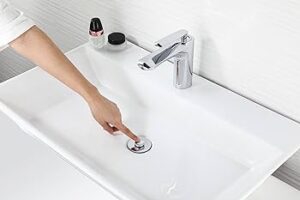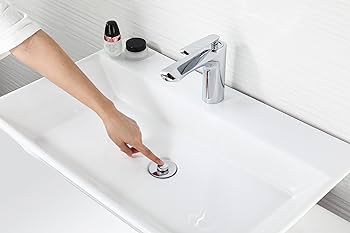Bathroom Sink Stopper Stuck If your bathroom sink stopper is stuck, there are several steps you can take to troubleshoot and fix the issue. Here is a comprehensive guide with detailed steps:
1. Understanding the Sink Stopper Mechanism
Bathroom sink stoppers typically use a lever system connected to a pivot rod and a lift rod. When you pull the lift rod, it moves the pivot rod, which raises or lowers the stopper.
2. Tools and Materials Needed
- Adjustable wrench or pliers
- Screwdriver (flathead or Phillips, depending on your setup)
- Plumber’s tape (optional)
- Cleaning supplies (soap, water, brush)
- Replacement parts (if needed)

3. Steps to Fix a Stuck Sink Stopper
Step 1: Identify the Problem
- Partial blockage: Hair, soap scum, or other debris might be blocking the stopper.
- Mechanical failure: The linkage connecting the stopper to the lift rod may be broken or disconnected.
Step 2: Remove Visible Debris
- Clear the sink: Remove any standing water and visible debris around the stopper.
- Clean around the stopper: Use a brush and cleaning solution to remove grime that might be causing the stopper to stick.
Step 3: Access the Stopper Mechanism
- Locate the pivot rod: Under the sink, find the horizontal rod connected to the drainpipe.
- Disconnect the pivot rod: Use pliers or a wrench to loosen the nut holding the pivot rod in place. Carefully pull the rod out of the drainpipe.
Step 4: Remove the Stopper
- Lift the stopper out: With the pivot rod disconnected, you should be able to lift the stopper straight out of the sink.
- Inspect the stopper and rod: Look for any damage or buildup of debris. Clean them thoroughly.
Step 5: Check the Linkage
- Inspect the lift rod: Ensure the lift rod (the vertical rod connected to the sink faucet) is still attached to the clevis (the flat piece with multiple holes where the lift rod connects).
- Adjust or reattach the clevis: If the clevis is loose or disconnected, reattach it securely. You may need to adjust the position of the pivot rod in the clevis to ensure smooth operation.
Step 6: Reassemble the Stopper Mechanism
- Reinsert the stopper: Place the stopper back into the drain opening in the sink.
- Reconnect the pivot rod: Slide the pivot rod back into place, ensuring it goes through the hole in the stopper’s tailpiece. Tighten the nut to secure it.
Step 7: Test the Stopper
- Operate the lift rod: Pull the lift rod up and down to check if the stopper moves freely. If it’s still stuck, double-check the connections and adjustments.
- Run water: Allow water to flow into the sink to test the stopper’s ability to seal and drain.
Step 8: Additional Tips
- Lubrication: If the stopper or pivot rod feels stiff, you can apply a small amount of plumber’s grease to the moving parts.
- Replacement: If the stopper or any components are damaged, consider replacing them. Universal sink stopper kits are available at hardware stores.
4. Preventive Maintenance
- Regular cleaning: Periodically remove the stopper and clean it along with the drainpipe to prevent buildup.
- Use drain covers: Install a drain cover to catch hair and debris, reducing the risk of blockages.
Conclusion
Fixing a stuck bathroom sink stopper involves understanding the mechanism, identifying the problem, and carefully disassembling and cleaning the components. By following these detailed steps, you can restore the functionality of your sink stopper and maintain it to prevent future issues. If problems persist, consider consulting a professional plumber for assistance.
Read Also.How To Install Under Cabinet Microwave?


